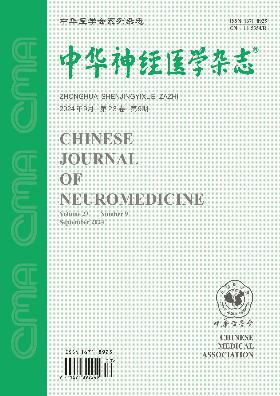Effect of hypertonic saline combined with magnesium sulfate on severe craniocerebral injury
Q4 Medicine
引用次数: 0
Abstract
Objective To explore the effect of hypertonic saline combined with magnesium sulfate on severe craniocerebral injury. Methods Patients with severe craniocerebral injury admitted to our hospital from September 2017 to February 2019 were selected prospectively. With the informed consent of the patients' families, the patients were divided into control group and experimental group according to the random number table. Patients in the two groups accepted intracranial pressure monitoring; patients in the experimental group additionally accepted magnesium sulfate combined with hypertonic saline for a continuous use of 7 d. Incidences of high intracranial pressure, epilepsy, low intracranial perfusion, cerebral vasospasm, cerebral infarction, and intracranial pressure rebound, total mannitol dosages one week after injury, serum neuron specific enolase (NSE) level, and Glasgow outcome scale (GOS) scores and mortality rate 3 months after injury were analyzed and compared between the two groups. Results A total of 93 patients were enrolled; 47 were into the control group and 46 into the experimental group. There were no significant differences in age, gender, Glasgow coma scale (GCS) scores and NSE levels at admission, and percentages of patients accepted craniotomy evacuation of hematoma or bone flap decompression between the two groups (P>0.05). As compared with those in the control group, the total mannitol dosage one week after injury and serum NSE concentration were significantly lower, and GOS scores 3 months after injury in the experimental group were significantly higher(P<0.05). Patients in the experimental group had significantly lower incidences of high intracranial pressure, cerebral vasospasm and intracranial pressure rebound as compared with patients in the control group (P<0.05). Conclusion Hypertonic saline combined with magnesium sulfate can improve the prognoses of severe craniocerebral injury; it has few side effects and is cheap; it might be an effective cerebral protective agent. Key words: Severe craniocerebral injury; Hypertonic saline; Magnesium sulfate; Intracranial pressure; Cerebral vasospasm; Prognosis高渗盐水联合硫酸镁治疗重型颅脑损伤的疗效观察
目的探讨高渗盐水联合硫酸镁治疗重型颅脑损伤的疗效。方法前瞻性选择2017年9月至2019年2月我院收治的重型颅脑损伤患者。在征得患者家属知情同意的情况下,按照随机数字表将患者分为对照组和实验组。两组患者均接受颅内压监测;实验组患者在对照组基础上加用硫酸镁联合高渗生理盐水连续使用7 d。损伤后1周甘露醇总剂量、血清神经元特异性烯醇化酶(NSE)水平、高颅内压发生率、癫痫发生率、低颅内灌流发生率、脑血管痉挛发生率、脑梗死发生率、颅内压反弹发生率、损伤后1周甘露醇总剂量、分析比较两组伤后3个月格拉斯哥结局量表(GOS)评分及死亡率。结果共纳入93例患者;对照组47例,实验组46例。两组患者年龄、性别、入院时格拉斯哥昏迷量表(GCS)评分、NSE水平、开颅血肿引流或骨瓣减压的比例比较,差异均无统计学意义(P>0.05)。与对照组相比,实验组伤后1周甘露醇总剂量、血清NSE浓度均显著降低,伤后3个月GOS评分均显著升高(P<0.05)。实验组患者高颅内压、脑血管痉挛、颅内压反弹发生率明显低于对照组(P<0.05)。结论高渗盐水联合硫酸镁可改善重型颅脑损伤患者的预后;它几乎没有副作用,而且价格便宜;它可能是一种有效的脑保护剂。关键词:重型颅脑损伤;高渗盐水;硫酸镁;颅内压;脑血管痉挛;预后
本文章由计算机程序翻译,如有差异,请以英文原文为准。
求助全文
约1分钟内获得全文
求助全文
来源期刊

中华神经医学杂志
Psychology-Neuropsychology and Physiological Psychology
CiteScore
0.30
自引率
0.00%
发文量
6272
期刊介绍:
 求助内容:
求助内容: 应助结果提醒方式:
应助结果提醒方式:


